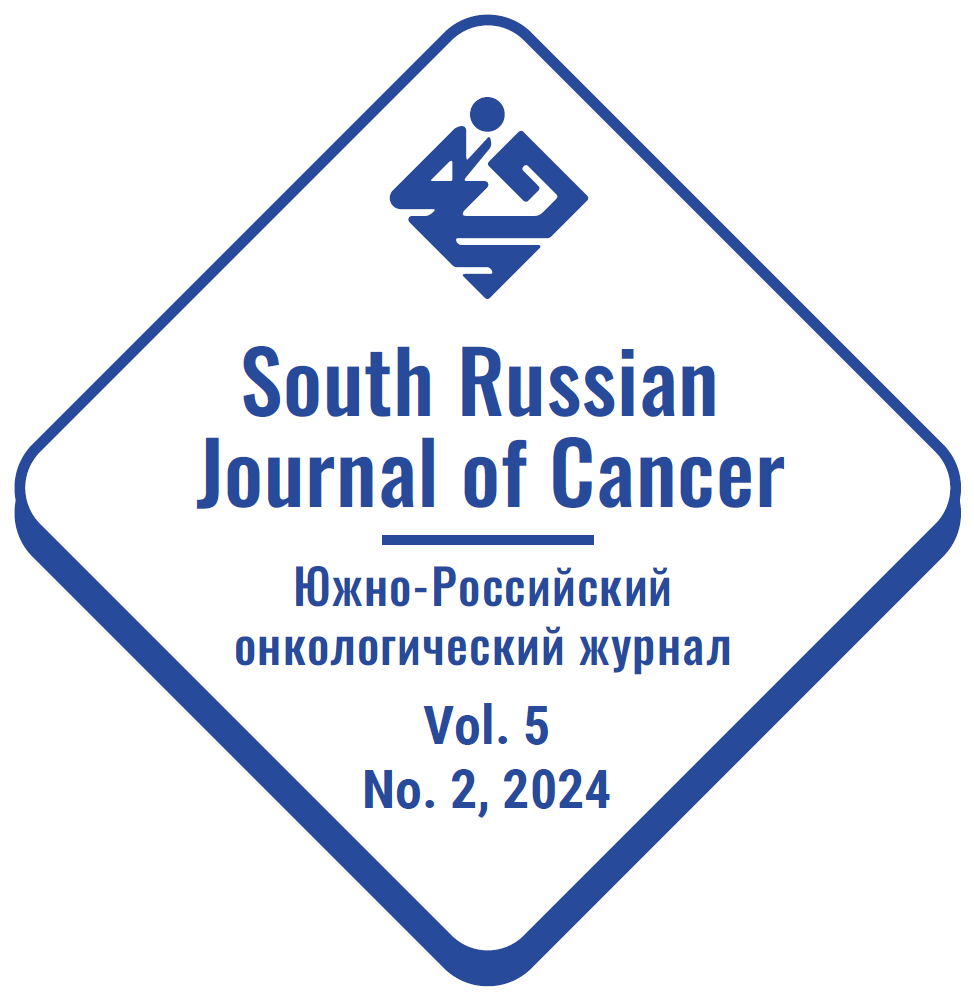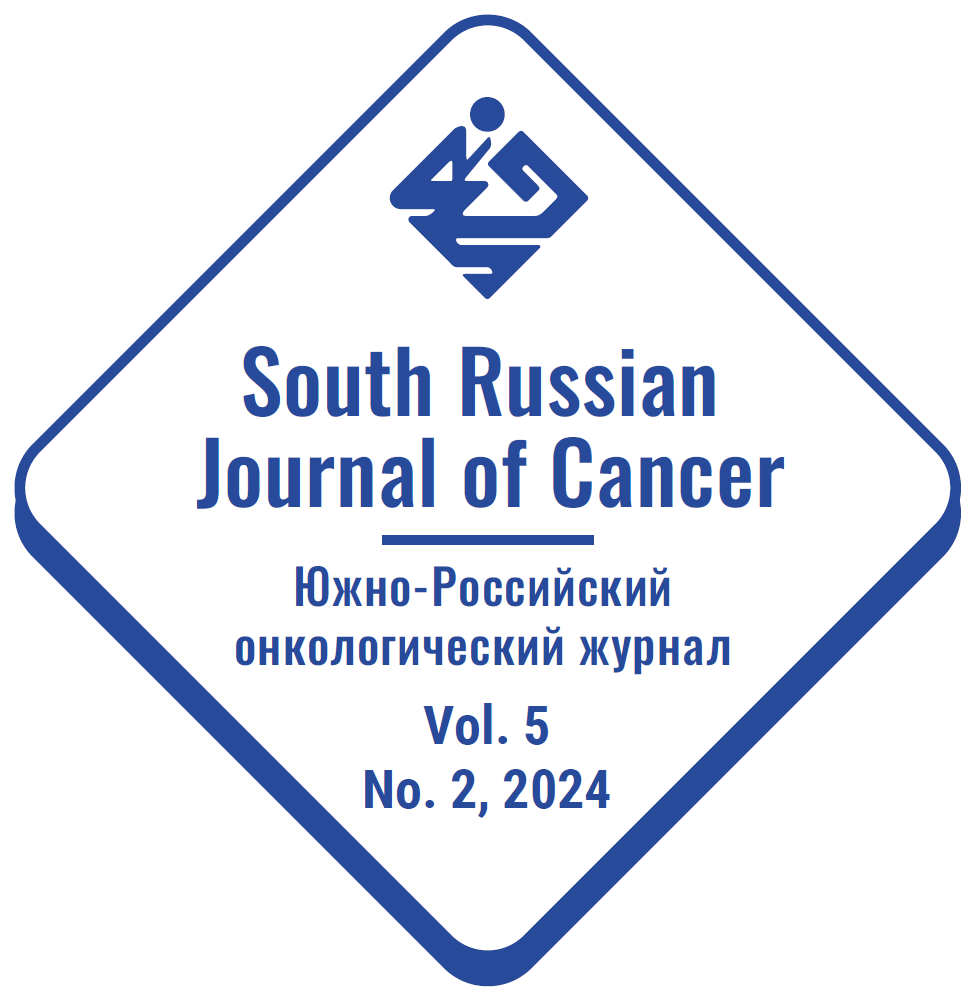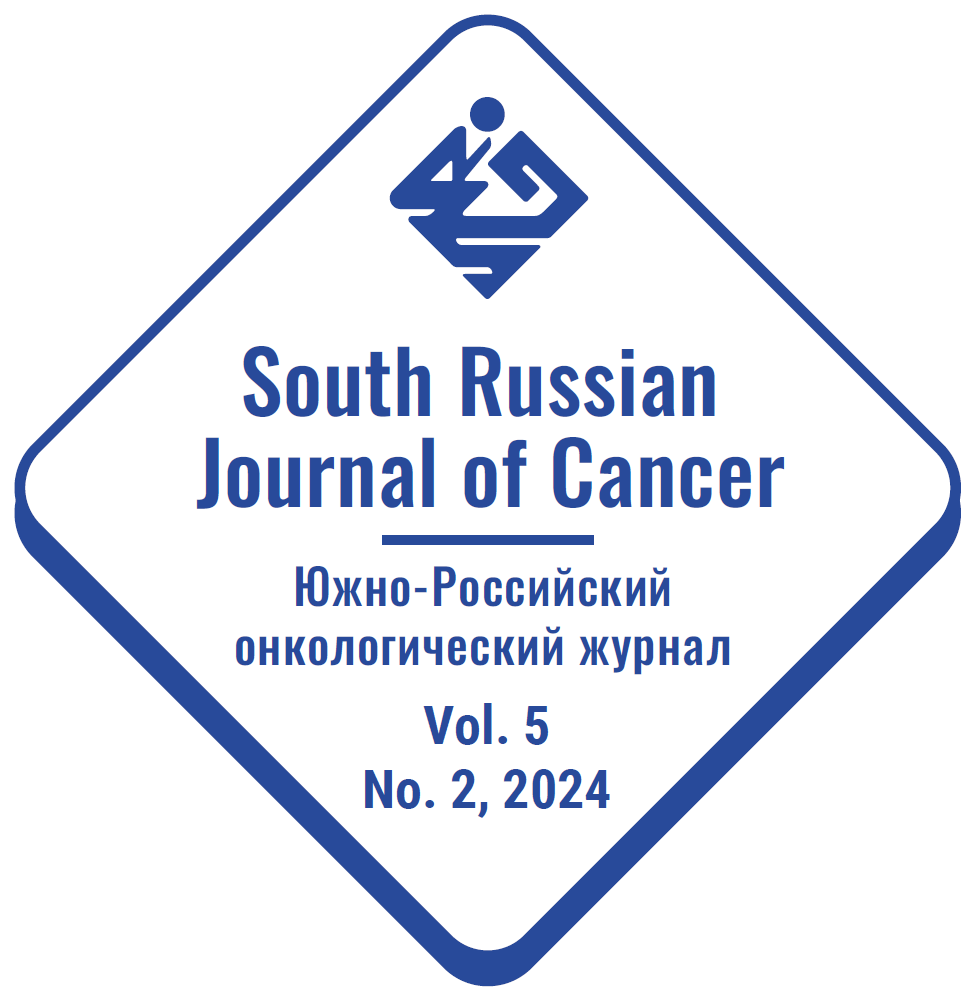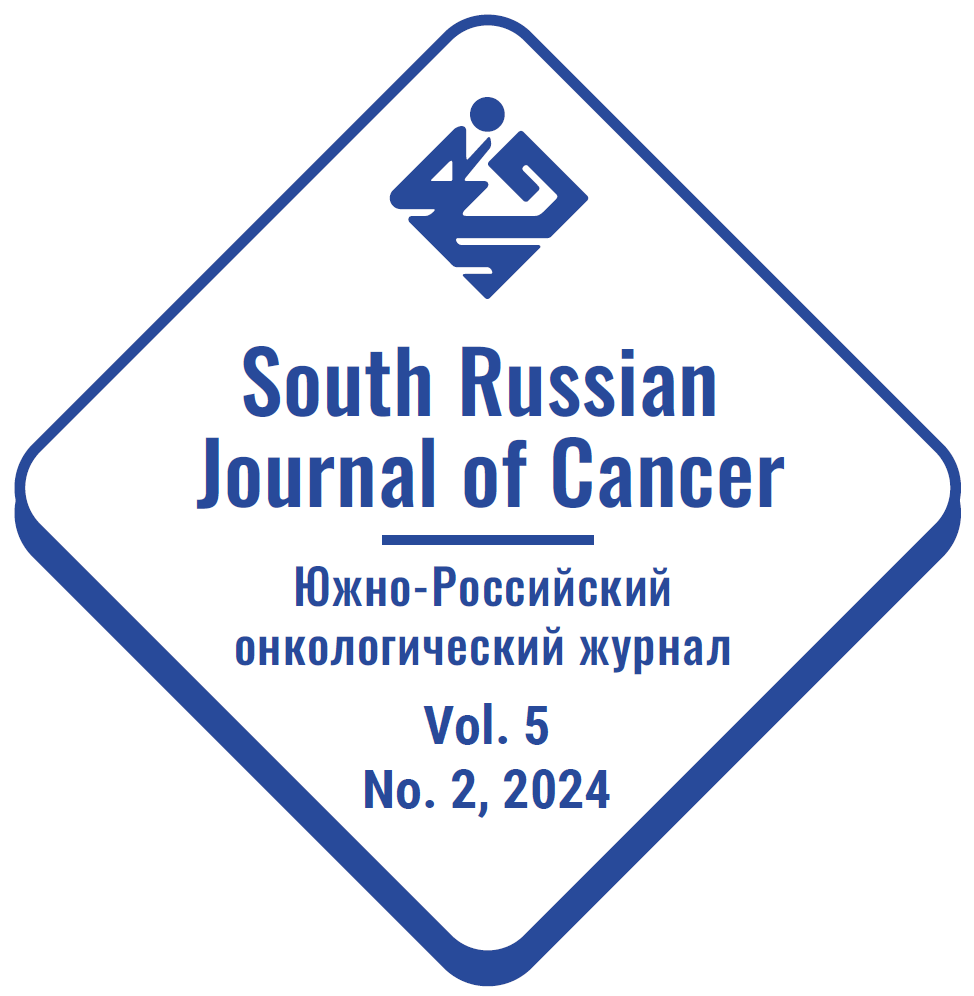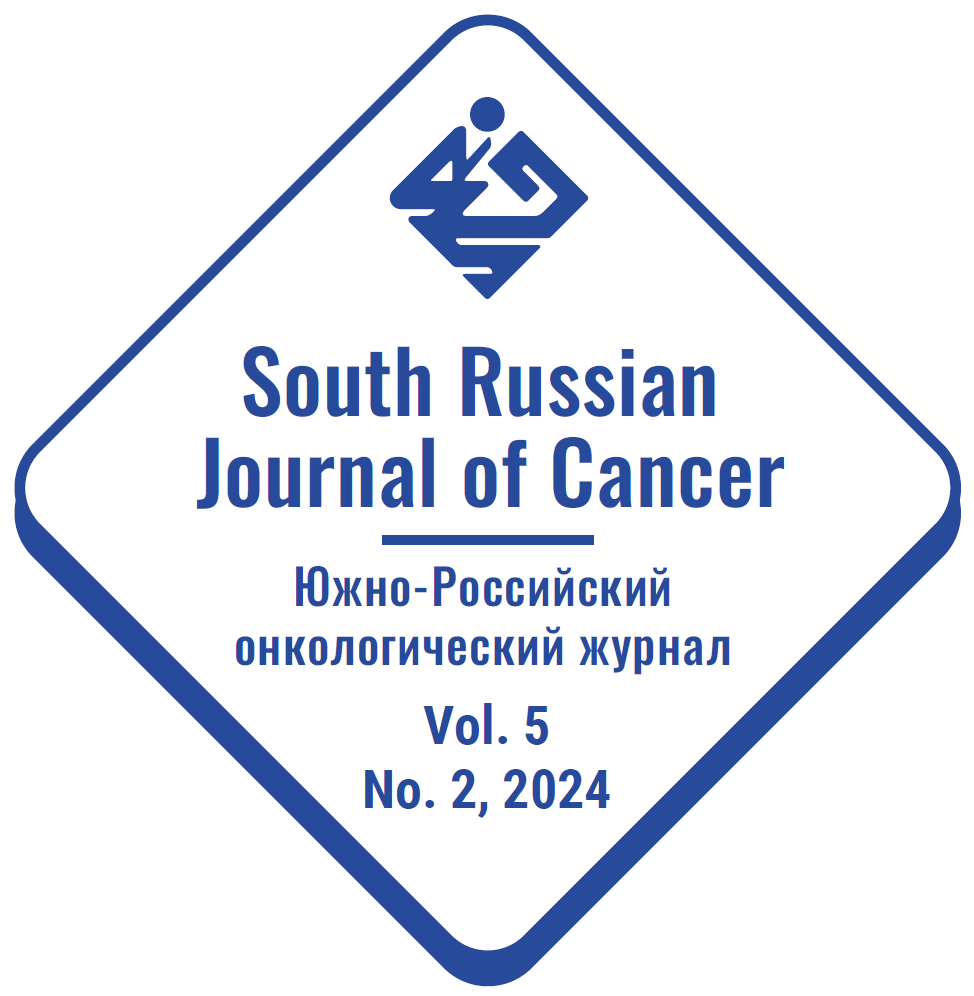ORIGINAL ARTICLES
Purpose of the study. Evaluation of the effectiveness of extracranial stereotactic radiation therapy in various fractionation regimens in the treatment of patients with metastatic vertebral lesions.
Patients and methods. The study included 12 patients with metastatic spinal lesions who underwent extracranial stereotactic radiation therapy (SBRT) on a Novalis Tx linear accelerator, Varian, in radiosurgery mode (SRS; in 1 fraction) and hypofractionation mode (SFD 5Gy, TFD 25Gy, 5 fractions) in the period from 01/01/2020 to 03/31/2022. The assessment of local control was carried out using positron emission tomography – computed tomography (PET-CT) from 18FDG. The intensity of the pain syndrome before and after radiation was assessed using a visual analog pain scale (VAS).
Results. 19 vertebrae with metastatic lesions were irradiated in 12 patients. The SBRT technique in hypofractionation mode was used in 6 (50 %) patients, in radiosurgery (SRS) mode was used in 4 (34 %) patients, in 2 (17 %) patients a combination of irradiation techniques was used on various affected segments of the spinal column. The general tumor volume (GTV) averaged 30.56 = 7.8 km2. When using the radiosurgical irradiation regimen, SFD ranged from 16 to 18 Gy. When using the hypofractionation technique, the total focal dose (TFD) was 25 Gy, a single focal dose (SFD) was 5 Gy.
Conclusion. Stereotactic radiation therapy and radiosurgery of metastatic vertebral tumors without compression of neural structures provides local tumor control in 92 % of patients within 6 months and in 83 % of patients within 1 year, regression of pain after irradiation – in 67 % of patients.
Purpose of the study. Was to reveal the effect of urokinase gene knockout in male and female mice with transplanted B16/F10 melanoma on the functions of the fibrinolytic system units.
Materials and methods. Male and female mice were used: main group with genetically modified mice C57BL/6-Plautm1. 1Bug – ThisPlauGFDhu/GFDhu (uPA-/-); control group with С57Bl/6 (uPA+/+) mice. B16/F10 melanoma was transplanted by the standard methods to the animals, and levels of plasminogen (PG), plasmin (PAP), urokinase receptor uPAR, content (AG) and activity (act) of uPA, t-P A and PAI-I were measured with ELISA (Cussabio, China) in 10 % tumor homogenates and peritumoral area after 3 weeks of tumor growth.
Results. The activity and levels of urokinase in intact uPA-/- animals were significantly (by 100–860 times) inhibited, compared to uPA+/+, but uPAR levels were unchanged in females and were 1.9 times lower in males. PAP levels in uPA-/- mice were 2.1–4.2 times higher than in uPA+/+ animals. The growth of B16/F10 melanoma in uPA-/- mice was slower and metastasizing was suppressed, but their survival was not improved. The dynamics of changes in components of the fibrinolytic system in presence of melanoma growth differed in uPA-/- mice, compared to uPA+/+ animals: PAP levels in tumor samples decreased by over 2 times, uPA levels and activity were not increased, PAI was practically unchanged, but activity of t-P A elevated by 3.8–8.2 times, as well as in uPA+/+ mice.
Conclusion. Despite the suppression of the growth and metastasis of the primary tumor nodes in uPA-/- mice, their average survival was not improved, which indicates that the mechanisms of tumor are complex and there are alternative biological pathways supporting melanoma to survive in conditions of the urokinase gene knockout.
Purpose of the study. To study the function of the sphincter in patients with rectal cancer after chemoradiotherapy using the method of high-resolution anorectal manometry.
Patients and methods. The study included 30 patients with cancer of the middle and lower ampullary rectum, who underwent combined treatment at the National Medical Research Center of Oncology. The patients underwent a course of neoadjuvant gamma radiation therapy using capecitabine. High-resolution anorectal manometry was performed before the start of treatment and 2 months after completion of chemoradiotherapy to study the functional parameters of the sphincter apparatus. The severity of anorectal dysfunction was assessed using the Wexner anal incontinence scale.
Results. According to high-resolution anorectal manometry, the average pressure of the anal canal at rest decreased by 1.4 times (p < 0.05), and the average absolute compression pressure with voluntary contraction decreased by 1.2 times (p = 0.0012) after neoadjuvant chemoradiotherapy. A comparative assessment of the maximum absolute compression pressure at this stage of treatment did not allow us to trace a significant difference between its value before the start of radiation therapy and 2 months after its completion (p > 0.05). An increase in threshold sensitivity volumes was noted in 23 patients (p = 0.16). The use of the Wexner scale didn’t show a statistically significant change in the median scores according to the results of patient surveys following the completion of treatment (5.2 vs. 5.5 points, p > 0.05).
Conclusions. Radiation therapy has an effect on anorectal function, which may contribute to the occurrence of low anterior resection syndrome after surgical treatment. For this reason, it is now necessary to carefully consider the risks of developing anorectal dysfunction. Equally important is the use of methods for the prevention of low anterior resection syndrome for patients who have received combined treatment for rectal cancer.
Purpose of the study. The purpose of this research was to investigate the effect of in vivo hypoxic conditions on the proliferative potential of HepG2 liver cancer cells.
Materials and methods. Human liver cancer cells of the HepG2 line have been cultured. The HepG2 cell suspension was injected subcutaneously into mice in an amount of 5 × 106 to obtain a xenograft. Tumor nodes that had reached the required size were divided into fragments and transplanted into the orthotopic site. Balb/c nude mice with implanted HepG2 liver cancer xenograft were used in this experiment. The mice with tumor implanted in the liver were divided into two groups, intact and hypoxic. Mice from the second group underwent liver blood flow reduction by occlusion of the portal triad for 20 minutes. Tumor nodes were extracted for histological and immunohistochemical staining for proliferation marker Ki-67 on the 4th day after the procedures. The proportion of positively stained cells was calculated, and the results were statistically analyzed using the Statistica 10.0 software.
Results. Orthotopic models of liver cancer in Balb/c Nude mice were obtained. Histological and immunohistochemical studies were carried out. Histological analysis showed that hepatocellular carcinoma is characterized by an average degree of differentiation. In the tissues of these xenografts, by using immunohistochemical analysis for the proliferation marker Ki-67, it was possible to identify statistically significant differences between the two groups, i.e. intact and the one with reduction of blood flow. The proportion of immunopositive cells was 65 [65–70] % and 19 [15–25] %, respectively.
Conclusion. A tendency to decreased proliferative activity of tumor cells after hepatic blood flow reduction, i.e. hypoxia exposure, was demonstrated. Our data indicate that the proliferative activity of tumor cells is directly related to the microenvironment, and to the hypoxic environment in particular. Further study of the effect of hypoxia on the processes of growth and development of malignant tumors may contribute to a deeper understanding of the biological features of tumors and their treatment.
Purpose of the study. Assessment of the level of certain cytokines in the saliva of patients with primary locally advanced cancer of the oral mucosa in addition to surgical treatment with intraoperative PDT (IPDT).
Patients and methods. Patients with primary locally advanced cancer of the oral mucosa T3-4aN0-2M0 were divided into 2 groups: the main group (30 patients) underwent radical tumor removal supplemented with IPDT and the control group (30 patients) without addition. IPDT was performed using Latus-T (farah) and a chlorin E6 photosensitizer. Cytokine levels were determined in unstimulated whole saliva the day before, on the 3rd and on the 7th day after the operation by the ELISA multiplex analysis method.
Results. A similar dynamic of the cytokine profile of patients of both groups was shown: on the 3rd day after surgery, the levels of G-CSF, IL-6, MIP-1β increased, and GM-CSF and IFN-γ decreased compared with baseline values. On the 7th day, the dynamics of G-CSF, GM-CSF, IL-6 persisted, while IL-8, IL-10, IL-12 changed to the opposite.
Intergroup differences were revealed in the level of IL-1β - on day 3, an increase in the main group and a decrease in the control group. The level of IL-7 on day 7 decreased sharply in the control group and increased statistically significantly in patients receiving IPDT. The main group showed a 4.8-fold increase in IL-8 on day 3 and its 3.6-fold drop on day 7 with the opposite dynamics in the control group. The TNF-α level increased only in the main group on day 7, and in the control group it decreased by 3 and recovered on day 7. On day 3, the MCP-1 level increased in the main group and decreased in the control group. The level of IL-17 in the main group increased on the 3rd day with a further decrease below the baseline, and in the control group it decreased on the 3rd day, followed by a recovery on the 7th. An increase in IL-5 and IL-13 levels on day 3 was noted only in the control group, however, the level of IL-5 in both study periods in the main group was lower than in the control group.
Conclusion. IPDT in patients with primary locally advanced oral cancer causes changes in the cytokine composition of saliva during the first week after surgery, some of which can be associated with an elongation of the relapse-free period in such patients.
Purpose of the study. Study of the characteristics of human papillomavirus (HPV) infection, comparison of HPV status, molecular and genetic parameters of HPV high risk (HR) with the clinical and morphological characteristics of cervical cancer.
Materials and methods. The study included 240 patients with morphologically verified cervical cancer stages I–III, in whom the presence of HPV DNA of 14 genotypes was examined before treatment; upon detection, viral load (VL), the presence and degree of DNA integration into the genome of the host cell were examined.
Results. A number of statistically significant associative relationships have been identified between the molecular and genetic parameters of HPV infection and clinical and morphological indicators of the tumor process, in particular the relationship of HPV-negative CC with age and stage of the disease; HPV infection with several genotypes and HPV genotype – with the histological type of tumor; VL – with age, stage and histological type of tumor. Significant associative connections have been established between the molecular genetic parameters of the virus itself: genotype and level of VL, genotype and integration of HPV DNA into the host genome, as well as a negative linear correlation between VL and the degree of integration.
Conclusion. The obtained data on the relationship between the molecular and genetic parameters of HPV infection and traditional prognostic factors can become the basis for further research on the development of prognostic models for the purpose of personalizing multimodal treatment programs.



